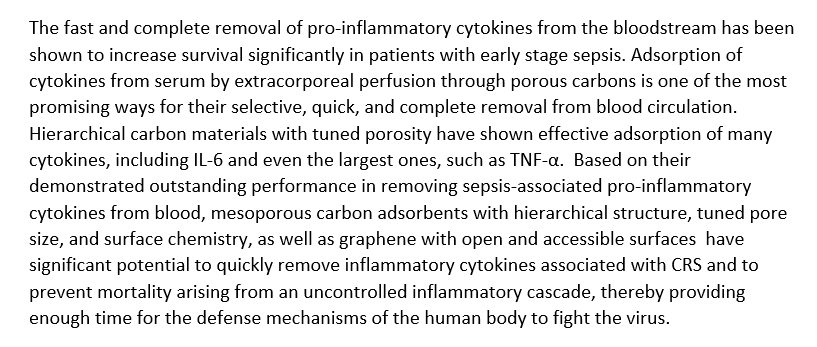thank you and hava a nice day :) Article: Can Nanotechnology Help to Control the Cytokine Storm? One of the main features of COVID-19 is the triggering of a cytokine storm in the body, also known as cytokine release syndrome (CRS), which results from an excessive immune
question: Can you summarize and explain for me what you want to tell in the article below? When I read it myself, I do not understand exactly what is meant by the article. It would be nice if you could highlight the important points. You can use them in a figure or diagram to explain. thank you and hava a nice day :)
Article:
Can Nanotechnology Help to Control the Cytokine Storm?
One of the main features of COVID-19 is the triggering of a cytokine storm in the body, also known as cytokine release syndrome (CRS), which results from an excessive immune response and leads to the severe deterioration of patient health. This inflammatory storm is one of the major causes of the acute respiratory distress syndrome (ARDS) that is often associated with multiple-organ failure, representing the leading causes of death in critical patients. In particular, the role of interleukin (IL)-6 has been highlighted in patients requiring assisted ventilation. Ongoing clinical trials are testing drugs that block the receptor of IL-6 (Tocilizumab, an anti-IL-6 receptor antibody, and Sarilumab) or IL-6 itself (Siltuximab).
Whereas a well-regulated cytokine response that is rapidly triggered by the host’s innate immunity can serve to prevent and to counteract an infection, an excessive, unbalanced, prolonged immune response can seriously harm the body. Therefore, therapeutic strategies aimed at effectively suppressing the cytokine storm are under investigation. Nanomaterials have been exploited to adjust the immune response to an optimized level, and such proprieties might be explored to inhibit cytokine releases. Nanosystems can enhance the specificity/efficiency of immunosuppressant delivery to target immune cells, with consequent reductions in drug dose, drug distribution to nontarget tissues and organs, and possible side effects. In addition, specific nanotools can be designed to evade the immune system and to enhance the solubility of poorly soluble immunosuppressant agents; the potential of finely tuning their surface charge opens possibilities for encapsulation strategies and offers accommodation for a high drug load. All of these mechanisms may also occur simultaneously, enhancing the activity of immunosuppressive agents.
Concerning the role of macrophages in COVID-19, the presence of ACE2-expressing CD68+CD169+ macrophages containing SARS-CoV-2 nucleoprotein antigen and showing an increased release of IL-6 was observed in infected spleen and lymph nodes. Notably, immunohistochemical and immunofluorescence analyses of lymph nodes and spleen tissue from autopsy samples of patients who died from COVID-19 revealed lymphocytic apoptosis. The tissues infected by SARS-CoV-2 also showed an upregulated expression of Fas, suggesting a role for CD169+ macrophages in viral spreading, aberrant inflammation, and activation-induced lymphocyte apoptosis. Moreover, histological examinations of biopsy samples of patients who died from COVID-19 revealed an increased alveolar exudate due to the extended neutrophil and monocyte infiltrate in lung capillaries with fibrin deposition, probably leading to difficulties in gas exchange. Through nanomedicine, we envision therapeutic approaches aimed at targeting specific immune subpopulations to avoid these complications, and different nanomaterials have already been explored for their specific impact on different immune cell subpopulations. Octadecylamine-functionalized and dexamethasone-adsorbed nanodiamond promotes anti-inflammatory and proregenerative behavior in human macrophages in vitro. A low dose of this functionalized nanodiamond also reduced macrophage infiltration and expression of proinflammatory mediators iNOS and tumor necrosis factor (TNF)-α in mice. Overall, these results suggest that nanodiamond particles may be useful as an inherently immunomodulatory platform.
Nanosystems can enhance the specificity/efficiency of immunosuppressant delivery to target immune cells, with consequent reductions in drug dose, drug distribution to nontarget tissues and organs, and possible side effects.

Step by step
Solved in 2 steps









